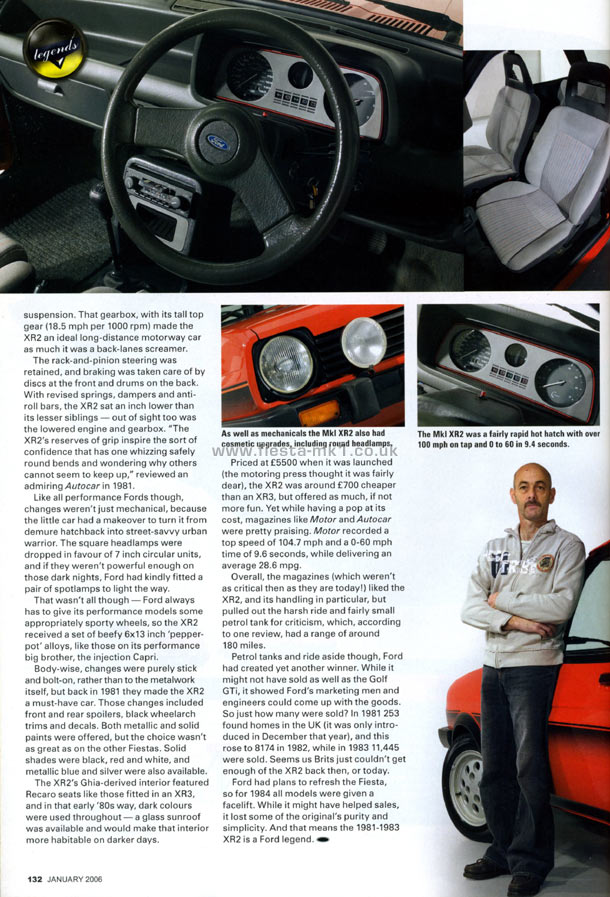Copy of Article Text Below
.....suspension. That gearbox, with its tall top gear (18.5 mph per 1000 rpm) made the XR2 an ideal long-distance motorway car as much it was a back-lanes screamer.
The rack-and-pinion steering was retained, and braking was taken care of by discs at the front and drums on the back. With revised springs, dampers and anti-roll bars, the XR2 sat an inch lower than its lesser siblings - out of sight too was the lowered engine and gearbox. "The XR2's reserves of grip inspire the sort of confidence that has one whizzing safely round bends and wondering why others cannot seem to keep up," reviewed an admiring Autocar in 1981.
Like all performance Fords though, changes weren't just mechanical, because the little car had a makeover to turn it from demure hatchback into street-savvy urban warrior. The square headlamps were dropped in favour of 7 inch circular units, and if they weren't powerful enough on those dark nights. Ford had kindly fitted a pair of spotlamps to light the way.
That wasn't all though - Ford always has to give its performance models some appropriately sporty wheels, so the XR2 received a set of beefy 6x13 inch 'pepper-pot' alloys, like those on its performance big brother, the injection Capri.
Body-wise, changes were purely stick and bolt-on, rather than to the metalwork itself, but back in 1981 they made the XR2 a must-have car. Those changes included front and rear spoilers, black wheelarch trims and decals. Both metallic and solid paints were offered, but the choice wasn't as great as on the other Fiestas. Solid shades were black, red and white, and metallic blue and silver were also available.
The XR2's Ghia-derived interior featured Recaro seats like those fitted in an XR3, and in that early '80s way, dark colours were used throughout - a glass sunroof was available and would make that interior more habitable on darker days.
Priced at £5500 when it was launched (the motoring press thought it was fairly dear), the XR2 was around £700 cheaper than an XR3, but offered as much, if not more fun. Yet while having a pop at its cost, magazines like Motor and Autocar were pretty praising. Motor recorded a top speed of 104.7 mph and a 0-60 mph time of 9.6 seconds, while delivering an average 28.6 mpg.
Overall, the magazines (which weren't as critical then as they are today!) liked the XR2, and its handling in particular, but pulled out the harsh ride and fairly small petrol tank for criticism, which, according to one review, had a range of around 180 miles.
Petrol tanks and ride aside though. Ford had created yet another winner. While it might not have sold as well as the Golf GTi, it showed Ford's marketing men and engineers could come up with the goods. So just how many were sold? In 1981 253 found homes in the UK (it was only introduced in December that year), and this rose to 8174 in 1982, while in 1983 11,445 were sold. Seems us Brits just couldn't get enough of the XR2 back then, or today.
Ford had plans to refresh the Fiesta, so for 1984 all models were given a facelift. While it might have helped sales, it lost some of the original's purity and simplicity. And that means the 1981-1983 XR2 is a Ford legend.
Captions -
Middle - As well as mechanicals the Mk1 XR2 also had cosmetic upgrades, including round headlamps.
Middle-Right - The Mk1 XR2 was a fairly rapid hot hatch with over 100 mph on tap and 0 to 60 in 9.4 seconds.
|







